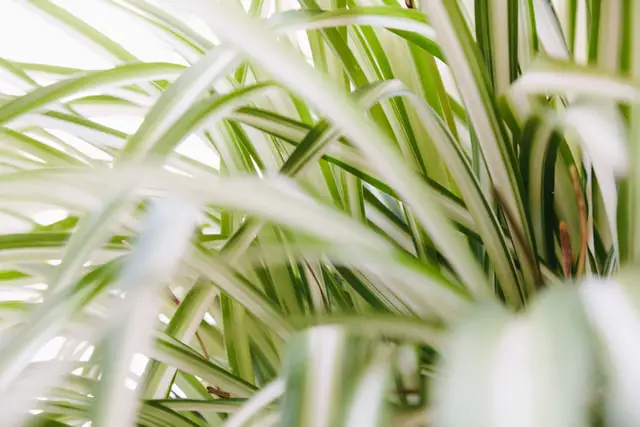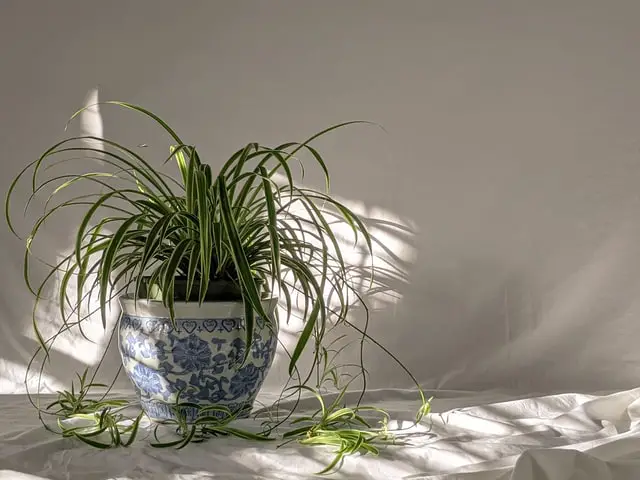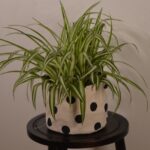Spider plants are said to be one of the easiest houseplants one can have. However, leaf folding may occur. This article will help you detect the causes of spider plant leaves folding and give you some ideas on how to fix it.
Table of Contents
Why Are My Spider Plant Leaves Folding?
The spider plant is one of the most popular indoor houseplants. They require little attention and can withstand a broad range of temperatures, levels of light, and even a certain amount of sloppiness on your part. They do, however, occasionally encounter issues.
A sign that your spider plant is under stress is if the leaves begin to fold inward toward the stem.
Spider Plant, Bonnie Curly

Let me first discuss the Bonnie Curly Spider Plant before we get into the many causes of stress that your plant may be experiencing. There is a particular type of spider plant that has leaves that are folded and spiraled. If your plant looks healthy and has swirly leaves like the one above, it’s probably a Bonnie variety, and you don’t need to do anything.
If, on the other hand, the leaves of your spider plant are folding inward and the plant itself does not appear to be in good health, you have a problem.
Read more: The complete guide to repotting a spider plant
4 Reasons Why Your Spider Plant Leaves Are Folding
There are a few different reasons why the leaves of spider plants may fold inward. Spider plants are resilient and adaptable houseplants, which is fortunate. Therefore, if you see that the leaves of your spider plant are folding inward, there is a very good possibility that your spider plant will recover quickly.
We’ll start with the most common concerns that the spider plant faces before moving on to less prevalent ones. It is important to go through the list step-by-step as you investigate the root cause of your plant’s stress.
Read more: Why Is My Spider Plant Pale And Limp?
Cause #1: Underwatering
The most common reason for leaves to curl is when they are underwatered. When there is not enough water for them, the leaves will fold in on themselves. A spider plant that has been submerged in water may also appear lifeless and dried out, rather than vibrant and healthy.
To our good fortune, both the diagnosis and the solution to this issue are straightforward.
Test the moisture content of the soil by inserting your finger to a depth of one to two inches. Do not just inspect the surface of the potting soil. Put your finger down on the ground and look about. Is there a sense of wetness in the soil? If not, then your plant requires watering.
If your spider plant was suffering from underwatering, it will swiftly recover. It’s possible that you’ll see a change in as little as a few hours, or it might take a number of days.
If you have recently (within the previous few days) watered your plant, wait another day or so to observe if the leaves unfold. It is preferable to err on the side of underwatering rather than overwatering when making adjustments.
Read more: Why Spider Plant Leaves Bend?
Cause #2: Excessive watering causes root rot.
When there is an excessive amount of water in the soil, the roots might rot. This might occur if you overwatered your plant or if the soil is not draining properly.
Overwatering
Overwatering will be tested in the same manner that insufficient water will be tested. Your first order of business is going to be determining the amount of moisture that is present in the soil. Put your finger down into the soil so that it is approximately 1 to 2 inches deep. Moisture, but not wetness, should be felt in the soil.
If there is any wetness at all, then you should cease watering. Wait until the soil has completely dried up before you attempt to water it again.
It should only take a few days for the spider plant to recover from the mild overwatering when it is allowed to dry out.
Drainage
If the soil seems damp and it has been many days since it was last watered, there may be a drainage issue.
Make sure your spider plant’s pot has a drainage hole at the bottom. In the event that it does not, you will need to repot the plant. The presence of drainage holes enables excess water to escape, preventing you from accidentally saturating your plant with too much water.
If the container has drainage holes, you should examine them to ensure that they are not obstructed in any way. If they are, then it’s likely time to repot your plant in a larger container. If you cover the drainage holes with material that still lets water pass through it, you can prevent them from becoming clogged in the future. A piece of shattered pottery, a tiny rock, or a mesh screen made of plastic are all viable options.
Read more: How Do You Fix A Wilted Spider Plant?
How to Detect Root Rot
Root rot is likely to have occurred on your plant if it has been allowed to remain in moist soil for an extended period of time. Root rot is going to be the challenge that will be the most difficult to tackle. It is possible that the plant can be saved if the damage is not too severe.
Remove your spider plant from its container, give it a light shake to remove any extra soil, and then examine its roots. Roots of healthy plants are white in color. It is a sign that your plant has root rot if any of the roots are slimy, brown, or black. To remove the decaying roots from the plant, you can use a pair of sharp scissors or pruning shears.
You may need to prune the plant’s leaves in addition to the root system if the root system that was left behind is not large enough to maintain the plant on its own. A little root system cannot deliver nutrients to a big plant.
After the plant has been trimmed, repot it into a container that is somewhat smaller and use new soil. Make use of an indoor potting mix of high grade. Check for drainage holes in the new pot. You should also consider using a terra-cotta container instead of a plastic one since it will dry out more quickly than a plastic pot and will lower the possibility that you will overwater the plant in the future.
Read more: Should I Cut Bent Spider Plant Leaves?
Cause #3: Pest Infestation
If your spider plant has been infested by insects, you may notice that its leaves begin to fold.
Other signs, on the other hand, are more likely to appear, and those symptoms will assist you in identifying the pest.
The most prevalent types of pests that attack spider plants include:
- spider mites
- Scale Insects
- Whiteflies
- Aphids
Spider Mites
Spider mites are notoriously difficult to identify since, according to their name, they are extremely little in size. On the other hand, if you see tiny webs on your plant, the pest in question is most likely a spider mite.
Scale Insects
Scales are tiny parasites that feed on the sap that your spider plant produces and can be seen on the leaves. They have the appearance of a little bump on the plant. They can have either a round or oval shape, and the hue can range from very light brown to very dark brown.
Whiteflies
Whiteflies are another type of bug that feeds on sap. If you look closely at your plant and see that it has some little white insects, then you most likely have whiteflies. Honeydew, a sticky fluid that may be seen on the leaves, is another indication that whiteflies are present.
Aphids
Aphids are another type of bug that feeds on sap, and their bodies are delicate and may take on practically any hue. In fact, they frequently blend in with the color of the plant that you have. In most cases, you will find them grouped together.
Read more: Why is my Spider Plant drooping?
Pest Control
All of these pests can be treated in the same manner.
- First, a little misting of water should be applied to the plant. You may either put them in the shower or take them outdoors to spray them with the hose from your garden. Most of the insects will be washed away by the water, and it will also remove the honeydew and webs.
- Then, to kill any leftover insects, spray the plants with a combination of neem oil and insecticidal soap. I have a bottle of neem oil mixed up all the time so I may use it whenever I need it.
- In addition to this, I prefer to incorporate some neem oil combination into the soil so that I can eliminate anything that could be hiding below the surface.
- Place any plants that have been infected into quarantine to prevent the spread of pests to your other houseplants. Maintain strict vigilance over your plants over the next two weeks. It is possible that the pest control procedure will need to be repeated once or twice.
- While your plant is recuperating, you should refrain from fertilizing it, as the new growth may attract additional pests.
Cause #4: Poor lighting conditions
Your plant could experience stress if it has inadequate lighting. After you have resolved all of the previous issues, you should think about its placement and the amount of light that it is exposed to.
Spider plants require strong, indirect light to thrive. Excessive direct sunlight might cause your plant to dry out soon (which leads to the leaves curling). It also has the potential to turn the white variegation green. Another indication of too much direct sunlight is brown patches.
Move your plant to a different place if it is subjected to an excessive amount of direct sunlight, or install a sheer window covering to diffuse the light entering the room.
It is quite improbable that leaves would fold if there is insufficient light. Spider plants are extremely resistant to circumstances with little or no light. Because of this, they are wonderful choices for homes and workplaces that have limited space for plants.
If, on the other hand, you observe that the leaves of your spider plant are becoming yellow and drooping, this is an indication that they are not receiving sufficient indirect light.
Conclusion
Why Are My Spider Plant Leaves Folding?
Keeping an eye on your plant is the greatest approach to avoid troubles. Check it once a week to ensure that everything is in order. A plant that is in good health will have glossy leaves that are also smooth and arching.
If the leaves are folding inward, this is a warning that something is amiss with the plant. It’s most likely due to incorrect watering, so that’s the first thing to rule out. Next, look for any kind of pest. Finally, ensure that it receives adequate lighting.
Photo by Alberto Nicoletta on Unsplash
Photo by Susan Wilkinson on Unsplash



